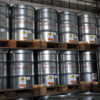Investors have taken gold profits as ongoing fears of instability around U.S. President Donald Trump’s plans for binding international tariffs.
Gold prices dipped to the lowest prices in over a week on Tuesday. Spot prices fell 1.4 per cent to $2,909.59 an ounce as, having hit its lowest level since February 17 earlier in the session. The precious metal reached its highest level at $2,956.15 on Monday.
Meanwhile, U.S. gold futures hovered 1.5 per cent lower at $2,918.80.
“You are seeing profit-taking as well as people looking to get to the sidelines and to re-establish positions at a lower price,” said Bob Haberkorn, senior market strategist at RJO Futures.
Safe-haven gold has reached eleven record highs this year, surpassing the significant $2,950/oz milestone. On Monday, Trump declared that tariffs on Canadian and Mexican imports were “on time and on schedule,” despite the countries’ efforts to strengthen border security and stop the flow of fentanyl into the U.S. before the March 4 deadline.
Speculators reduced net long positions by 13,605 contracts to 201,962 in the week to February 18. Meanwhile, investors and economists expect the Federal Reserve to respond “strongly and systematically” to inflation changes and the labour market. Higher inflation may prompt the Fed to keep rates higher, diminishing the appeal of non-yielding gold.
Read more: Calibre Mining’s mineral resource estimate in Talavera gives reasons for optimism
Read more: Equinox Gold acquires Calibre Mining for $2.6B
Goldman Sachs predicts gold could reach $3,100 per ounce
Investors are now awaiting Friday’s release of the U.S. Personal Consumption Expenditures report, the Fed’s preferred inflation gauge, for insights into the central bank’s rate-easing path and monetary policy. Spot silver shed 2.3 per cent to $31.61 an ounce, platinum dropped 0.5 per cent to $962.15, and palladium lost 1.9 per cent to $922.39. Earlier in the session, platinum and palladium prices fell to their lowest levels since January 30 and January 9, respectively.
This week, analysts at Goldman Sachs predicted the metal could reach US$3,100 an ounce by year’s end, with the possibility of hitting USD$3,300 if trade tensions persist. However, Huggins warns that the metal isn’t always a guaranteed win.
After the 2008 financial crisis, gold initially jumped 50 per cent but later fell from USD$1,800 to USD$1,100 over four years.
“You can lose 20 to 30 per cent on a gold investment, just like in the stock market or housing,” Huggins said.
Despite the risks, investors can access gold more easily than ever. Retail giant Costco began selling gold in late 2023, and investors can buy gold-backed funds on the stock market.
Rising gold prices can encourage higher gold production as mining companies respond to increased profit potential.
When gold prices climb, it becomes more economically viable to produce from deposits that were previously not cost-effective to mine
This could lead to increased exploration activities and expansions of existing operations. However, higher prices can also have mixed effects.
In some cases, it can drive higher operational costs, particularly if inflationary pressures are felt in mining costs. Additionally, as production increases, it could lead to concerns about oversupply, which might push prices down in the long term.
.














